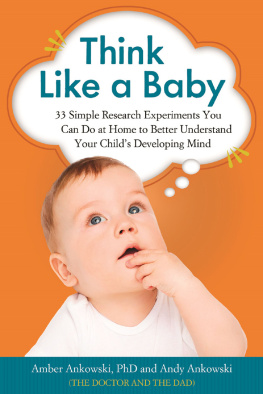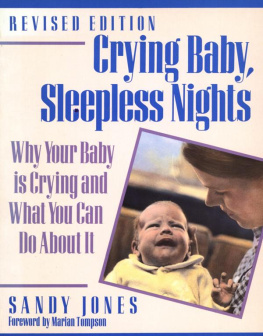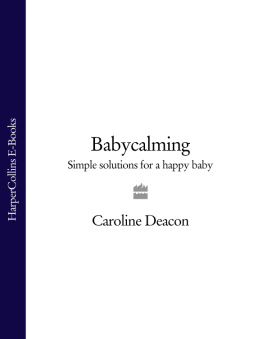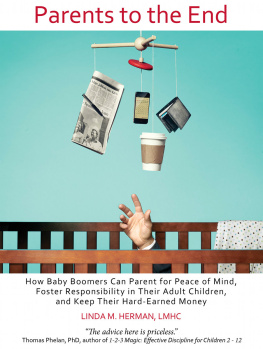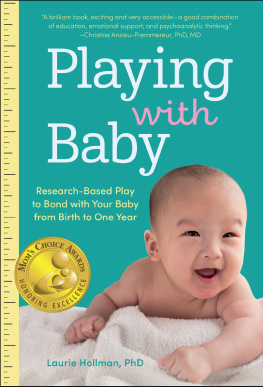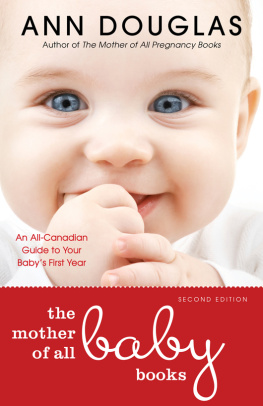
Copyright 2015 by Amber Ankowski and Andy Ankowski
All rights reserved
Published by Chicago Review Press Incorporated
814 North Franklin Street
Chicago, Illinois 60610
ISBN 978-1-61373-063-8
Library of Congress Cataloging-in-Publication Data
Ankowski, Amber.
Think like a baby : 33 simple research experiments you can do at home to better understand your childs developing mind / Amber Ankowski and Andy Ankowski.
pages cm
Summary: This book gives parents tremendous insight into their childrens physical, cognitive, language, and social development Think Like a Baby features 33 lab-tested research experiments parents can easily re-create at home to give them tremendous insight into their childrens physical, cognitive, language, and social development. Presented in a lighthearted, entertaining, yet authoritative manner, each experiment is followed by a discussion of its practical implications for parentswhy to bring more than one toy to a restaurant, why not to overuse a baby walker, which baby gadgets to buy (and not to buy), surefire tactics for keeping keys and cell phones out of babys mouth, how to get her to be perfectly happy eating just half of her dessert, and much more. With this book, amazed parents wont just read about how their children are developing; why they behave as they do; and how to be a great, effective parent, they will actually see it all happening while interacting and having fun with their child at the same timeProvided by publisher.
Includes bibliographical references and index.
ISBN 978-1-61373-063-8 (paperback)
1. InfantsDevelopment. 2. Infant psychology. 3. Parent and infant. 4. Parenting. I. Ankowski, Andy. II. Title.
HQ774.A68 2015
305.232dc23
2014039013
Cover and interior design: Sarah Olson
Cover photo: dolgachov/Bigstock.com
Interior illustrations: Jim Spence
Printed in the United States of America
5 4 3 2 1
For Sammy and Freddy,
our beloved little guinea pigs.
Contents
Index
Introduction

N o matter how many baby books you read, videos you watch, or classes you attend before your child is born, at some point after the little one arrives, youre bound to face that moment.
You know the one.
First, you completely forget how to breathe. Then your eyes grow so big that your forehead disappears. Your heart starts beating in your ears, two of your hairs immediately turn gray, and all you can do is ask yourself, What the heck am I supposed to do now?
When that moment happens to you (and if it hasnt already, trust usit will), its easy to start thinking that maybe you just dont have what it takes to make it as a parent. After all, you dont really know the best way to take care of your kid. You cant see whats going on inside her adorable little baby brain. And if it werent for that color-changing strip thingy, you wouldnt even be able to tell what was going on inside her diaper half the time.
But why is understanding our children so difficult? Is there any way for us to get better at it? And is it even possible to become a new parent without feeling the panic-stricken need to revert to the fetal position ourselves?
Thats exactly what this bookand the academic research studies its based oncan help you find out.
Psychologists who study how the human mind thinks, learns, and develops over time know that if parents can get inside their kids heads, theyll have a much better chance of determining what it is they needand the best ways to give it to them. They also know that figuring out what kids are thinking isnt as simple as it is with adults. After all, newborns havent learned how to speak our language yet, so we cant just ask them what theyre thinking. And even when toddlers do start talking, we tend to spend less time discussing the intricacies of their thought processes and more time trying to decipher all their adorable mispronunciations. Mimi? Thats Mommy. Cumpootoob? Thats computer, of course.
So how have these researchers come to understand whats going on inside a childs mind? The answer comes right out of your middle school science textbook: experiments.
For those of you whose memory about things you learned way back when you were twelve is a bit fuzzy, heres a quick refresher on the subject. In a nutshell, an experiment is a carefully designed test meant to support or disprove a hypothesis. That hypothesis thing? Its basically your best guess as to what you think will happen when you perform your experiment. So to use an example that appears in lots of seventh graders science fair projects every year, suppose you start wondering about how plants grow. You hypothesize, or guess, that giving plants fertilizer will make them grow faster. So as an experiment, you plant two identical seeds in two identical pots, put them in the same window, and give them the same amount of water every day. The only difference is that you give one of the plants fertilizer as well. Over the next few weeks, youll be able to observe and measure how quickly each plant grows, which should tell you whether your hypothesis was right or wrong.
(Spoiler alert: the one with fertilizer grows faster. Duh.)
Experiments have helped people make all sorts of important discoveries over time, like the cure for polio, the secret of space travel, and the surprising fact that fried chicken and waffles taste awesome together.
Theyve also taught us just about everything we know in the field of child development. Each day, thousands of researchers from around the world are creating, performing, and evaluating results from experiments that give us insight into the way children think. Although these experiments often involve elaborately constructed laboratory equipment and complicated statistical analyses, the basic ideas behind them are actually pretty simple.
Thats the main reason this book exists: to take a bunch of classic, proven child development experiments that highly trained researchers have learned from over the course of many years, and then simplify them, so that you can use them to learn about your own kids. Experimentation can teach you the smartest ways to talk to your child, the times when plunking your kids in front of the TV is OK, and which popular baby gadgets you really ought to avoid. The experiments in this book are quick and easy activities you can do with your child, yet they provide tremendous insight into whats going on inside your kids brain at different points of development. After all, theyre the same experiments the experts have used. Its just now, weve taken them out of the lab and brought them into your home.
For you skeptical parents out there who at this very moment are thinking something like, I dont know about this book. I mean, performing scientific experiments on my sweet, little, adorable monkey-poo just seems wrong, we have a couple comments especially for you. First of all, monkey-poo is a supercute nickname. Keep using that as long as your kid lets you. (Las Vegas oddsmakers are setting the over-under line at age nine and a half.) And second, performing experiments on your child isnt wrong at allits one of the most natural things in the world. In fact, when you really think about raising a kid, the whole darn thing is one great big experiment.
For example:
You might notice that, although hes perfect in just about every other way, little Junior tends to wake the whole house screaming bloody murder every forty-five minutes all night long. So you perform a little experiment, shelling out fifty bucks on a blanket specially designed to prevent your newborn from moving his limbs even a fraction of an inch. And lo and behold, turning him into a tightly wrapped medieval torture burrito works! At least for a couple of months. Then you discover that he wont even go to sleep until hes been bounced and rocked and walked around in circles until
Next page
